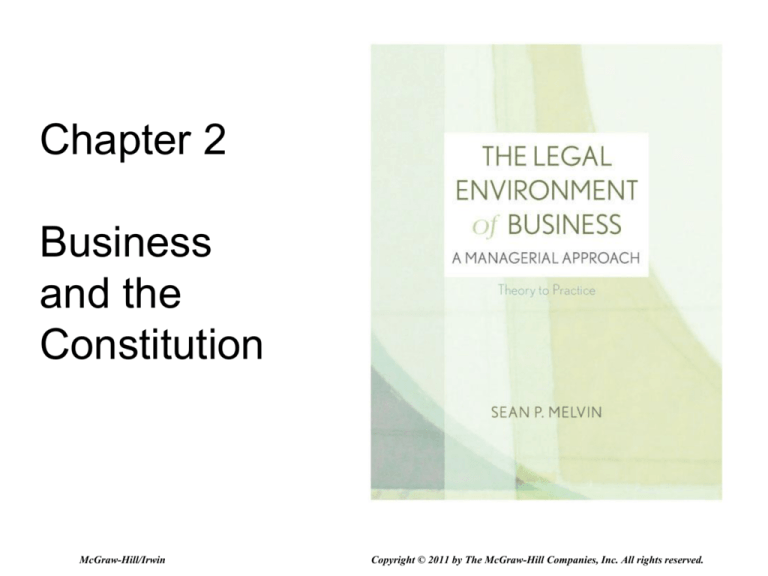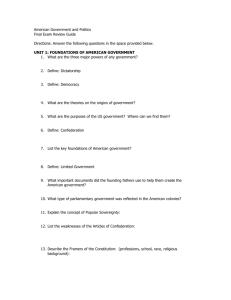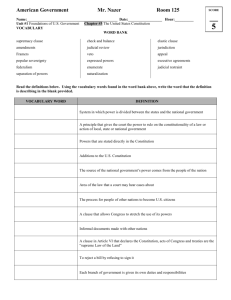
Chapter 2
Business
and the
Constitution
McGraw-Hill/Irwin
Copyright © 2011 by The McGraw-Hill Companies, Inc. All rights reserved.
Chapter Overview
• The structure of the U.S. Constitution and
individual state constitutions, and their
respective roles in the American legal system.
• The specific powers granted to the government
in the Constitution.
• The protections afforded by the Constitution
in the Bill of Rights and the 14th Amendment.
2-2
Functions of the Constitution
• (1) establishing a structure for the federal
government and rules for amending the
Constitution;
• (2) granting specific powers for the different
branches of government;
• (3) providing procedural protections for U.S.
citizens from wrongful government actions.
2-3
Structure of the Constitution
• Preamble
• Seven articles
• 27 amendments
2-4
Overview of Articles I, II
• Article I Establishes the legislative branch (A
Congress composed of the House of
Representatives and the Senate); sets
qualifications for members; grants congressional
powers (lawmaking).
• Article II Establishes the executive branch
(president); sets qualifications for the
presidency; grants executive powers
(enforcement of laws).
2-5
Overview of Articles III, IV, V
• Article III Establishes the judicial branch with a
federal system of courts, including a Supreme
Court; grants certain judicial powers.
• Article IV Establishes the relationship between
the states and the federal government;
describes how to admit new states to the Union.
• Article V Describes the process for amending
the Constitution.
2-6
Overview of Articles VI, VII
• Article VI Establishes the Constitution and
federal law as the supreme law of the United
States over any conflicting state law; authorizes
the national debt (Congress may borrow
money); public officials must take an oath to
support the Constitution.
• Article VII Lists the requirements for ratification
of the Constitution.
2-7
FEDERAL POWERS
The powers that generally impact business owners:
• (1) the power to regulate commerce
• (2) taxing the citizenry and commercial entities and
spending government funds (tax and spend provisions)
• (3) bankruptcy, patents, and copyrights
• (4) a more general implied authority to make all laws
necessary for carrying out its enumerated powers
2-8
Constitutional Checks and Balances
• This system of checks and balances is
called the separation of powers.
2-9
Judicial Review
• One of the central concepts in federal
Constitutional law is the notion that federal
courts have the right to invalidate state or
federal laws that are inconsistent with the
U.S. Constitution.
• The U.S. Supreme Court is the ultimate
judge
2-10
Standards of Review
• Court classifies the action into one of three
categories of scrutiny:
• (1) the rational basis category, or
• (2) intermediate-level scrutiny, or
• (3) strict scrutiny.
2-11
Supremacy Clause and Preemption
• U.S. Constitution provides that valid
federal laws (those made pursuant to
Congress’s constitutional authority and
that are constitutionally sound) are always
supreme to any conflicting state law
2-12
Cipollone v. Liggett Group, Inc., et al.,
505 U.S. 504 (1992)
• “Article VI of the Constitution provides that
the laws of the United States shall be the
supreme Law of the Land. Thus, [. . .] it
has been settled that state law that
conflicts with federal law is ‘without
effect.’
2-13
COMMERCE POWERS
• Congress’s broadest power is derived
from the Commerce Clause whereby
Congress is given the power to “regulate
Commerce among the several states.”
2-14
Application of Commerce Powers
• Congress has the express constitutional
authority to regulate:
– (1) channels of interstate commerce such as
railways and highways,
– (2) the instrumentalities of interstate
commerce such as vehicles used in shipping,
– (3) the articles moving in interstate commerce
2-15
Constitutional Restrictions on State
Regulation of Commerce
• The U.S. Supreme Court has ruled that
the mere existence of congressional
commerce powers restricts the states from
discriminating against or unduly burdening
interstate commerce.
2-16
Cavel International, Inc. v. Madigan,
500 F.3d 551 (7th Cir., 2007)
“The state statute regulates evenhandedly to effectuate a legitimate local
public interest, and its effects on interstate
commerce are only incidental, it should be
upheld unless the burden imposed on
such commerce is clearly excessive in
relation to the putative local benefits.”
2-17
TAX AND SPEND POWER
• Congress has a far-reaching power to tax
the citizenry and to spend the federal
government’s money in any way that
promotes the common defense and
general welfare.
2-18
Necessary and Proper Clause
• Congress may also place conditions on
the use of federal money in order to
achieve some public policy objective.
• Congress generally cites the Necessary
and Proper Clause as authorization to set
conditions on the spending.
2-19
CONSTITUTIONAL PROTECTIONS
• The Constitution provides protection for
the citizenry from unlawful or repressive
acts by the government.
• The Bill of Rights (the first ten
amendments) and other amendments that
guarantee the right of due process.
2-20
First Amendment
• “Congress shall make no law”:
• That allows government encroachment in
the areas of religion, press, speech,
assembly, and petition of grievances.
2-21
Speech by Corporations
• Commercial Speech
• Political Speech
• Which can be regulated?
2-22
Pagan v. Fruchey and Village of
Glendale, 492 F.3d 766 (6th Cir., 2007)
“Glendale’s attempt to justify its
ordinance amounts to nothing more than a
conclusory articulation of governmental
interests.”
2-23
Political Spending and Corporations
• Traditional distinctions between free
speech vs. spending limits on political
advertising.
• General rule prior to 2010 was that
spending limits were legal.
• See recent case on following slide.
2-24
Citizens United v. Federal Election
Commission
• In a 2010 case that attracted significant
media attention, the U.S. Supreme Court
ruled that the government may not ban all
political spending by corporations in
candidate elections.
2-25
Fourth Amendment
• The U.S. Supreme Court has
systematically applied a reasonableness
test to define the limits of when the
government may search without a warrant
based on probable cause that criminal
activity is possible.
2-26
Fifth Amendment
• This amendment does not apply to
corporate entities when the government is
seeking certain business records,
individual corporate officers and
employees are entitled to Fifth
Amendment protection when facing a
criminal investigation.
2-27
DUE PROCESS PROTECTIONS
• Fifth and Fourteenth Amendments
• These clauses protect individuals from
being deprived of “life, liberty, or property”
without due process of law
2-28
Fourteenth Amendment
• Perhaps the most important role of the
Fourteenth Amendment is that it makes
the Bill of Rights applicable to the states.
2-29
Equal Protection under the 14th
Amendment
• Fundamentally, the clause guarantees that
the government will treat people who are
similarly situated equally.
2-30
State Farm Mutual v. Campbell
538 U.S. 408 (2003)
“States possess discretion over the
imposition of punitive damages, but it is
well established that there are
constitutional limitations-the Due Process
Clause of the Fourteenth Amendment
prohibits the imposition of grossly
excessive or arbitrary punishments.”
2-31
PRIVACY
• Although not explicitly mentioned in the
Constitution, privacy rights play a central
role in our legal system.
• Common law origins
• Statutory law examples
2-32
Federal Statutes
• Health Insurance Portability and
Accountability Act (HIPPA)
• Uniting and Strengthening America by
Providing Appropriate Tools Required to
Intercept and Obstruct Terrorism Act
(called the USA Patriot Act)
2-33
Workplace Privacy
• Most privacy rights afforded by the U.S.
Constitution do not extend to the
workplace.
• Nonetheless, privacy rights have become
increasingly important to business owners
and managers as Congress and state
legislatures seek to clarify workplace
privacy rights by statute.
2-34
learning outcome checklist
• 2 - 1 Explain the federal system in the context of the U.S.
Constitution.
• 2 - 2 Describe the purpose and structure of the
Constitution.
• 2 - 3 List the major provisions of the first three articles of
the Constitution and explain the underlying assumptions
of coequal branches of government.
• 2 - 4 Identify the powers of Congress that impact
individuals and businesses.
2-35
learning outcome checklist
• 2 - 5 Recognize the role of judicial review in interpreting
the Constitution.
• 2 - 6 Understand the various applications and limits of
congressional power under the Commerce Clause.
• 2 - 7 Apply Constitutional restrictions on state regulation
of commerce in the business environment.
• 2 - 8 Explain how the tax and spend powers impact
business.
2-36
learning outcome checklist
• 2 - 9 List the major protections in the
Constitution’s Bill of Rights and explain how
they apply in the business environment.
• 2-10 Understand limits imposed on government
overreaching by virtue of the Due Process
Clause and Equal Protection Clause.
• 2 - 11 Explain the right of privacy that has been
recognized by the U.S. Supreme Court and
Congress.
2-37









